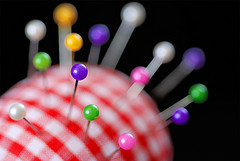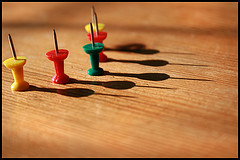What is it?
 |
| Obligatory picture of some pins (1) |
- it looks great;
- it automatically links every image back to the page from which it was 'pinned'.
What are people doing with it?
People are using Pinterest to collect together images and ideas around a multitude of themes: boards about weddings are popular, as are recipes, home decorating, and crafts.
You can find out what's been pinned from your webpages by using a URL in the form http://pinterest.com/source/yourURL/, e.g.:
- http://pinterest.com/source/lib.cam.ac.uk/
- http://pinterest.com/source/bl.uk/
- http://pinterest.com/source/tastykitchen.com/
How is this different to Flickr?
Well, for starters, it's not just about publishing your own images: it's a tool for bringing together images from lots of different sources. But even from the perspective of an institution wishing to create boards of its own photographs, Pinterest is much more easily social than Flickr, and it's much quicker to navigate.
Special collections folk - some ideas for what we could be doing
Pinterest provides a medium dedicated to finding, sharing and commenting on visual items. It's one that lots of people are using, and it's one that facilitates following items back to source if you want to find out more. It seems like a great forum for getting our stuff Out There. A few things spring to mind:
- put a 'pin it' button along with other social media sharing options next to images on your collections pages or online exhibitions pages - this will give visitors explicity permission to pin the pictures and thereby share them outside your usual visitor base. Lots of people will likely pin even without express permission, but it's good to be clear if you want to encourage this!
- use it to promote your own collections
- either for quick and dirty online exhibitions, or to highlight particular items from a physical exhibitions. I love this Brief History of Manchester made by Manchester Archives.
- pinning your own things is easy - you can either pin from your own website, or upload images direct to Pinterest
- you can also draw together material from other places that relates to your holdings in some way. Kettle's Yard art gallery has put together 'If you love Kettle's Yard you'll love...".
- It's easy to change your pins and boards whenever you need to.
 |
| Some more pins |
There has been much discussion about whether and how Pinterest and its users violate copyright. It's quite possible that pinning copyright images on Pinterest constitutes a violation of copyright, although that's not certain yet. I am not a copyright lawyer, and I don't know what the definitive line on this issue is. However, there are ways of using Pinterest without using copyright images at all: if you use images to which your institution holds the rights (with appropriate institutional agreement where required), or if you use creative-commons-licensed images (in accordance with the licence terms), or copyright-free images. It means you can't pin and re-pin at will without a moment's thought, but it's worth being punctilious when acting institutionally!

0 comments:
Post a Comment